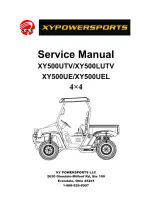
MOVING LOADS AND DOING WORK
When hauling a load, respect the maxi-
mum hauling capacity. See
PULLING
A TRAILER
subsection.
WARNING
Slack can cause the chain or cable
to break and snap back.
When pulling another vehicle, be sure
that someone is controlling the pulled
vehicle. They must brake and steer to
prevent the vehicle from going out of
control.
Reduce your speed when hauling a
load and turn gradually. Avoid hills and
rough terrain. Never attempt steep
hills. Allow more distance for braking,
especially on inclined surfaces. Be
careful not to skid or slide.
Pulling a Trailer
(if Equipped with Hitch)
NOTICE
A
BRP
approved
rear
hitch plate must be properly in-
stalled on the vehicle for hauling
trailers.
Riding this vehicle with a trailer sub-
stantially increases the risk of toppling,
especially on inclined slopes. If a trailer
is used behind the vehicle make sure
that its hitch is compatible with the
one on the vehicle. Make sure the
trailer is horizontal with the vehicle. (In
some instances a special extension
may have to be installed on the vehicle
hitch). Use security chains or cables to
secure the trailer with the vehicle.
Reduce your speed when pulling a
trailer and turn gradually. Avoid hills
and rough terrain.
Never attempt
steep hills. Allow more distance for
braking, especially on inclined sur-
faces. Be careful not to skid or slide.
Improperly loading a trailer may cause
loss of control. Respect the recom-
mended maximum hauling capacity
and maximum tongue load (Refer to
MAXIMUM HAULING CAPACITY
ta-
ble). Make sure there is at least some
weight on the tongue.
Always make sure load is evenly dis-
tributed and safely secured on the
trailer; an evenly balanced trailer is
easier to control.
Always put the shift lever to L (low
range) for hauling a trailer – in addition
to providing more torque, operating
in low range helps account for the in-
creased load on the rear tires.
When stopped or parked, block the ve-
hicle and trailer wheels from possible
movement.
Use caution when disconnecting a
loaded trailer; it or its load may topple
on you or others.
When hauling a trailer, respect the ma-
ximum hauling capacity indicated on
the label on the hitch.
MAXIMUM HAULING CAPACITY
TYPE OF
ATTACHMENT
TRAILER
LOAD
ALLOWED
TONGUE
WEIGHT
ALLOWED
50 mm (2 in)
x hitch ball
support
750 kg
(1,654 lb)
75 kg
(165 lb)
NOTE: Includes trailer and trailer load.
Ensure to properly load the trailer so
that tongue is always pushing on hitch
support and not pulling on hitch ball.
58
_______
SAFETY INFORMATION
________
Содержание CAN-AM OUTLANDER 6x6 2017 Series
Страница 9: ...SAFETY INFORMATION ________ SAFETY INFORMATION ________ 7...
Страница 87: ...VEHICLE INFORMATION _______________ 85...
Страница 98: ...EQUIPMENT sfvmo2014 012 072_f TYPICAL 96 ______________...
Страница 127: ...MAINTENANCE ______________ 125...
Страница 155: ...VEHICLE CARE vbs2012 006 001 SAFE FOR POLYPROPYLENE ______________ 153...
Страница 157: ...TECHNICAL INFORMATION ______________ 155...
Страница 173: ...TROUBLESHOOTING ______________ 171...
Страница 179: ...WARRANTY ______________ 177...
Страница 195: ...CUSTOMER INFORMATION ______________ 193...
Страница 199: ...CHANGE OF ADDRESS OWNERSHIP ______________ 197...
Страница 200: ...CHANGE OF ADDRESS OWNERSHIP This page is intentionally blank 198 ______________...
Страница 201: ...CHANGE OF ADDRESS OWNERSHIP ______________ 199...
Страница 202: ...CHANGE OF ADDRESS OWNERSHIP 200 ______________...
















































